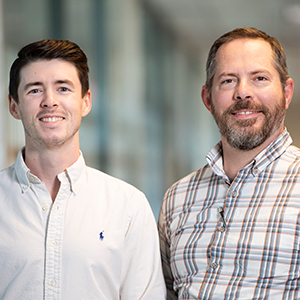 Rick Woychik, Ph.D., directs NIEHS and the National Toxicology Program. (Image courtesy of NIEHS)
Rick Woychik, Ph.D., directs NIEHS and the National Toxicology Program. (Image courtesy of NIEHS)Readers of this column know that one of my passions is to promote research into how the environment interacts with our unique genetic, epigenetic, and biological makeup, potentially influencing health and disease. But I recognize that people are not isolated biological entities — we live in society, and we are more than the sum of our genes and exposures. To better address the causes of poor health and to develop effective prevention strategies, scientists must also account for social factors involving housing, employment, education, nutrition, and discrimination, among others.
Kenneth Olden, Ph.D., who directed NIEHS from 1991 to 2005, realized that to strengthen environmental health sciences, reduce disparities, and improve public health, researchers need to understand the interplay of both physical and social environments. He emphasized the importance of outreach and community-based participatory research, and his thought leadership in these areas echoes throughout many institute initiatives today. Appreciation of social determinants of health, the topic of this month’s column, is part of the fabric of NIEHS.
 “I’m excited to see what scientific discoveries related to social determinants of health result from our new Research Coordinating Committee, and I can’t wait to collaborate with NIEHS and the other NIH institutes, centers, and offices,” said Zenk. (Photo courtesy of NINR)
“I’m excited to see what scientific discoveries related to social determinants of health result from our new Research Coordinating Committee, and I can’t wait to collaborate with NIEHS and the other NIH institutes, centers, and offices,” said Zenk. (Photo courtesy of NINR)I recently spoke with Shannon Zenk, Ph.D., who directs the National Institute of Nursing Research (NINR), to discuss the new Social Determinants of Health Research Coordinating Committee that she is spearheading across the National Institutes of Health (NIH). (I am proud to serve on the initiative’s executive committee.) Zenk described why analysis of such social determinants is a key aspect of biomedical research, and she identified knowledge gaps that NIEHS and other agencies can work to fill, such as how climate change affects health equity.
Zenk has had an illustrious career. Among other accomplishments, she was elected to the National Academy of Medicine in 2021; inducted into the International Nurse Researchers Hall of Fame in 2019; and elected as a fellow of the American Academy of Nursing in 2013. Zenk is a prolific scientist, having conducted groundbreaking research into built environments, food insecurity, and health disparities. Before taking the helm of NINR in 2020, she was a professor in the department of population health nursing science at the University of Illinois Chicago (UIC), and she was a fellow at the UIC Institute for Health Research and Policy.
Rick Woychik: For Environmental Factor readers, can you describe social determinants of health and explain why you think they are they an important part of biomedical research?
Shannon Zenk: We consider social determinants of health to be the conditions in which people are born, live, learn, work, play, and age that affect a wide range of health outcomes. Similar language has been used in definitions adopted by organizations such as the Centers for Disease Control and Prevention, the World Health Organization, and others.
Community conditions are a big part of the equation. Job opportunities, school quality, transportation systems, and greenspace are all part of social determinants of health, as are factors such as income, educational attainment, trauma, and housing.
We know that social and structural factors underlie many of the pervasive, persistent, and seemingly intractable health disparities that our nation faces. So, at NINR, we have added social determinants to our new strategic plan to really focus research on solutions that are powerful enough to address not just individual health outcomes but also more upstream factors that can affect the health of entire communities and populations. I think the COVID-19 pandemic revealed very clearly the consequences of not addressing social determinants of health, so I think for that reason alone, they are an important part of biomedical research.
RW: You recently launched an NIH-wide program focused on social determinants of health. Can you discuss the impetus for the initiative?
SZ: Social determinants account for the largest variance in health, far exceeding the contribution of genes and biology. Social and structural factors affect not only individual health but also population health, for better or worse, across a wide variety of diseases and conditions, and across stages of the life course. They also are thought to be fundamental drivers of health inequities. So, we cannot overstate the importance of understanding and addressing social determinants. And this is where the Research Coordinating Committee comes into play.
 Zenk noted that health disparities are often influenced by socioeconomic factors such as income, education, nutrition, housing, and neighborhood environments. (Photo courtesy of StunningArt / Shutterstock.com)
Zenk noted that health disparities are often influenced by socioeconomic factors such as income, education, nutrition, housing, and neighborhood environments. (Photo courtesy of StunningArt / Shutterstock.com)Our goal is to facilitate sharing of information and promote collaborations across NIH. We want to help develop the expertise and capacity necessary to identify knowledge gaps and promising research directions. I think there are opportunities to improve study methods and to develop joint initiatives such as trainings, seminars, and workshops that spur valuable partnerships. This is all about advancing scientific discovery.
RW: As you know, I have volunteered to be on the executive committee for this new program. What are your thoughts on how NIEHS and the broader environmental health sciences community can add value to the initiative?
SZ: We are delighted to have you be part of our team, and you have been integral in launching this effort. I think it is essential for NIEHS to be at the table because social determinants of health encompass the totality of the environments in which we live — physical and social. And we know that there are large environmental inequities. Low-income individuals and people of color are often disproportionately exposed to environmental hazards, and we need to look no further than the water crisis in Flint, Michigan, to see this.
In addition, we see disparities in exposure to air pollution and toxic substances, and inequitable access to greenspaces, safe sidewalks, and so forth. Of course, these are all aspects of the environment. So, in my view, NIEHS is a natural player in this broader conversation on social determinants. We certainly need your expertise as we aim to learn how to achieve health equity, think about how to measure environmental exposures, and incorporate those insights into new research.
Your institute also has a strong track record when it comes to community-based participatory research, and we want to leverage that expertise. In my view, when community members are included from the outset in research projects, scientists can achieve better results because they understand what people need and what study designs are appropriate for a given population. This results in more rigorous science and, hopefully, improvements to public health outcomes.
RW: You recently co-authored a thought-provoking paper in the Journal of the American Medical Association with NIH Acting Director Lawrence Tabak, D.D.S., Ph.D., and Eliseo Pérez-Stable, M.D., director of the National Institute on Minority Health and Health Disparities, titled “Research Opportunities to Address Nutrition Insecurity.” You outlined the importance of ensuring that Americans have access not just to enough food but also to high-quality food.
I completely agree, and I think there are implications for environmental health sciences research. For example, I am interested in how diet can potentially counteract the negative health effects of air pollution and other environmental exposures, and I know that some NIEHS grantees are investigating that very topic. What are some other areas of overlap between environmental health sciences research and studies involving social determinants of health?
SZ: One example involves climate change and health equity. Lately, I’ve been thinking a lot about how climate change intersects with social determinants. As you may know, my research is focused on neighborhoods and specifically the built environment, such as access to healthy foods and outdoor spaces, and how those factors influence health and disparities. But my lab is also investigating personal heat exposure and the implications for neighborhoods.
We know that neighborhoods are inequitable — some have more tree cover and green space, and those neighborhoods are cooler than ones with more concrete and other surfaces that absorb heat. Also, some houses are better insulated against the elements than others because of the materials used and because of differences in resources needed for upkeep.
Also, we know that populations that rent are even more vulnerable because they have less control over how their homes were built and maintained. Some people can afford cooling systems and the energy needed to run them, but others cannot. And some don't even have homes and thus have very little protection from the elements. Social determinants of health, such as education and income, are driving a lot of these differences. So, we need to think more broadly about the ways that climate change and environmental elements can influence our health.
For example, temperature affects our sleep, and sleep effects our health, sometimes in unexpected ways. When we don't sleep well, we might not have the mental and physical energy to exercise or to eat well. There are a lot of different pathways by which climate change and extreme temperatures can affect our health. However, I don’t think we know nearly enough about these complex interactions, and that is one reason I am excited to try to dig into this important area, and I hope that our new initiative spurs greater discovery, too.
RW: Earlier, you mentioned the NINR strategic plan and how it emphasizes social determinants. Can you tell Environmental Factor readers more about your institute and its goals?
SZ: Thank you for asking, and I would be delighted to talk more about NINR. We were founded as an NIH center in 1985, and then we were elevated to institute status in 1993. From the beginning, we have supported research that develops the scientific basis for clinical practice as well as policy. What we think sets us apart from other NIH institutes is that our research, which is based on nursing’s perspective, is focused on health solutions for people in the context of their lives and living conditions. So, it's a very contextualized understanding and approach to health.
Our strategic plan comprises five research lenses, including health equity, social determinants of health, population and community health, prevention and health promotion, and systems and models of care. We are committed to research that is innovative; applies rigorous methods; has the potential for significant impact; addresses challenges like climate change to help us better prepare for the future; and provides solutions to optimize health across clinical, community, and policy settings — all the spaces where nurses work.
We think our new framework really builds on the strengths of nursing research. It spans the intersection of health care and public health, and it encompasses the many settings where nurses engage in prevention, treatment, and care. People often think about nurses being in hospitals and clinics, but we also are in schools, workplaces, homes, long-term care facilities, justice settings, and, really, throughout the community. I am excited about the plan, and I can’t wait to collaborate with NIEHS and other NIH institutes.
Citation: Zenk SN, Tabak LA, Pérez-Stable EJ. 2022. Research opportunities to address nutrition insecurity and disparities. JAMA 327(20):1953–1954.
(Rick Woychik, Ph.D., directs NIEHS and the National Toxicology Program.)









